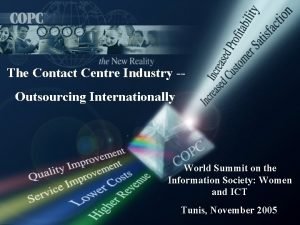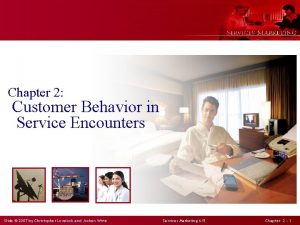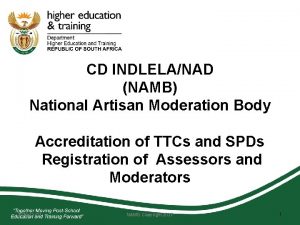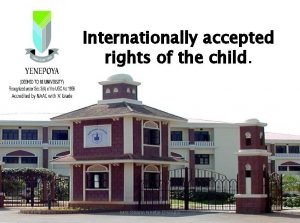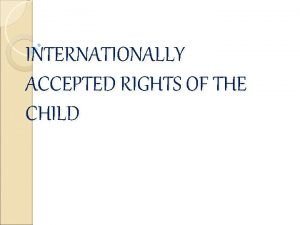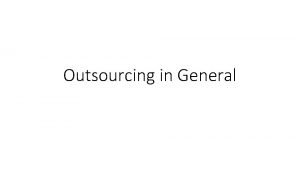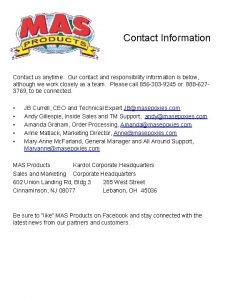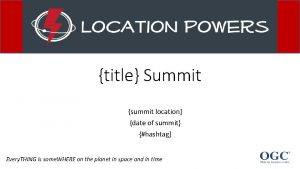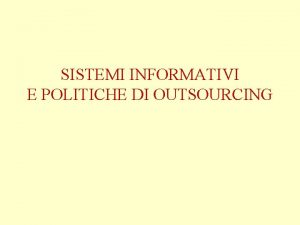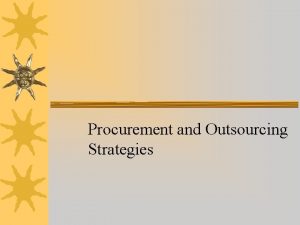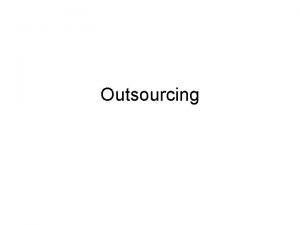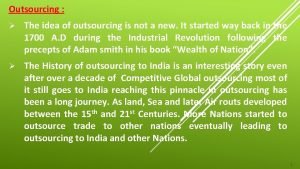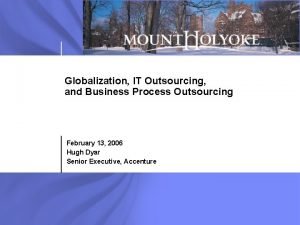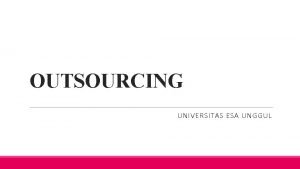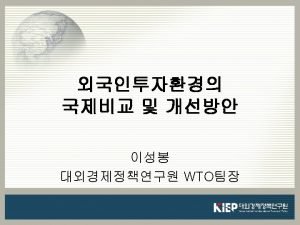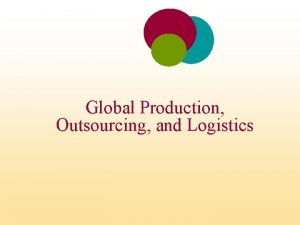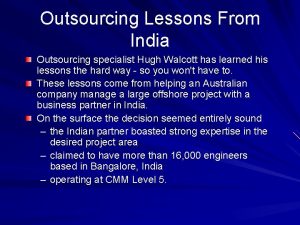The Contact Centre Industry Outsourcing Internationally World Summit




























- Slides: 28

The Contact Centre Industry -Outsourcing Internationally World Summit on the Information Society: Women and ICT Tunis, November 2005

Objectives of Presentation 1. How a developing nation can make use of the information technology and educated workforce to develop an outsourcing and offshoring call centre industry 2. Examples from India, Malaysia and the Philippines

Who is COPC Inc. ? Customer Operations Performance Center Inc. Founded in 1995 Grown to a worldwide staff of 60 associates in nine countries More than 750 onsite operational audits in 30 countries / average 10 audits per month 200, 000 contact center seats Operations of all sizes From 10 to 5, 000 customer contact seats Co-developers of the Industry Standards for contact centers worldwide

Global Footprint Offices in nine countries around the world Argentina – Australia – Brazil – Canada – India – Japan Singapore – United Kingdom – United States

Global Standard 200 Companies – 300 Locations 35 Countries – 6 Continents Canada United States England Dominican Republic Argentina Brazil Costa Rica Germany Ireland France Norway Netherlands South Africa Global Internal / External Japan Singapore Malaysia Philippines Hong Kong Australia India Operational Pakistan Environments

Evolution of economy Early 1900 s, the economy was predominantly driven by agriculture. The nations which had a strong agricultural production had a competitive advantage. Mid 1900 s, industrial revolution became a dominant force in driving the economy. Manufactured goods and products delivered competitive advantage to nations. Late 1900 s, the manufacturing economy gave way to the information economy where knowledge and information services play a key role in providing competitive advantage to a nation/company.

Key Terms and Relationships On. Shore: The Client’s domestic locations (e. g. Canada, US and Europe) Near. Shore: Typically countries near the On. Shore locations (e. g. , Mexico and the Caribbean) Offshore: Locations significantly distant from the Onshore geography (e. g. , India, the Philippines, and South Africa) Global Sourcing: The use of CSPs in multiple locations to service the Client’s customer transactions

Development of economy in emerging countries Singapore during her formative years of the 1960’s and 1970’s strong, effective and stable government investment in education and infrastructure attract large amounts of foreign direct investment India, over the past 5 years have developed a strong offshore industry with better educated people and low-cost workfoce

Why Companies Offshore? Top corporations are focusing more on core activities and outsource labor intensive service functions. Lower operating costs often dominate today´s company site selection criteria. Labor shortages/wage pressures are driving Contact Centers out of their home countries to low cost international locations. International telecommunication costs are dropping in many geographical areas.

Moving Offshore: Key Challenges for European and U. S. Companies which want to move their operations face two types of risks in deciding where to migrate transactions offshore: Location risks: Where should I go? Company risks: Who should I use? Additional risks include deciding which customer transactions to move offshore.

Moving Offshore: Key Challenges Location-specific factors Location – Distance Physical Cultural Political, economic, and social stability Buyer staff safety Tax policy – Incentives Customs regulations Ease of implementation Transportation (air services, courier services)

Moving Offshore: Key Challenges Location-specific factors Labor pool Size, skills, cost, labor laws Unemployment, income levels Work ethic, flexibility Attrition, absenteeism Work expectations (e. g. , company provided transportation, food, housing) Telecommunications infrastructure (carriers, fiber, cost) Reliability – redundancy Electric Power (Back-Up) Availability of replacement equipment

Moving Offshore: Key Challenges Company-specific factors Company-specific Range of Services Offered Cost of Services (Quoted and Actual) Ability to meet commitments & hit targets Implementation capability (time to volume – the ramp) Technology Platform (compatibility) Workforce Skills – both coming in and required time to train Voice/culture neutralization Attrition/Absenteeism Experience Management team (capabilities, depth, and tenure) With the offshore markets under considerations (“we can set up a site for you there”) With the specific products/services being moved offshore

India as an offshore site for U. S. and European companies Delhi Mumbai (Bombay) Pune Hyderabad Bangalore Chennai

Market Review: India Projected to grow 100%+ per year through 2005 Major players establishing “owned” centers 200 -250 contact centres, some without customers CSRs paid US$150 to US$300/month “all in” Provide services for $13 to $18/hour voice “all in” Connectivity improving Aggressively marketing to US/UK companies

India Strengths General • Stable economy • Stable socially/politically • Physically safe? • English speaking • Government support – in some parts Labor • Available (high unemployment) • Educated • Low cost • Good work ethic • Average absenteeism Weaknesses • • • Physical distance Cultural distance/difference Time difference – working daily at night Doesn’t show well “Expediting” payments Bureaucracy--slow implementation Attrition rates high – 50%+ Have to train “basic skills” § PC § Customer service § Typing § Language/accent/culture Lack flexibility Few experienced managers

India Strengths Infrastructure • New technology/equipment • New facilities • Telecom § Inexpensive § Improving availability • Power: Totally redundant Weaknesses • • Availability of critical equipment Availability, speed, and capability of repair technicians

Indian ITES - BPO Industry A US$ 5. 0 b industry and growing stronger

Indian ITES - BPO Industry Outsourcing of IT jobs to India could grow fivefold to $50 billion by 2008 if it can overcome a US labour backlash says a report by investment-analyst firm Brean Murray Institutional Research

Looking Ahead India has the opportunity to be a world leader One prediction is that by 2008, India will employ two million people as call centre staff Opportunity for severe price competition Will need to keep “eyes wide open” and aggressively compete with other countries/regions

Malaysia as an offshore site for U. S. and European companies Strengths General • Stable economy • Stable socially/politically • Physically safe • Ability to find English speaking staff • Government support • Little Bureaucracy Weaknesses • • Physical distance from the U. S. and Europe However, focusing on customers in South East Asian regions of Multi-Nationals

Malaysia as an offshore site for U. S. and European companies Strengths Labor • More experienced CCC managers compared to 2002 • Average absenteeism • Ability to find English, Cantonese and some Asian languages to provide service to Asian regions of U. S. companies Weaknesses • • No experience with (and no desire to) accent neutralization Unfamiliar with U. S. or European culture

Malaysia as an offshore site for U. S. and European companies Weaknesses Strengths Infrastructure • Available technology, power, telecom--things works here • Very limited experience with centers of size >1, 000

Philippines as an offshore site for U. S. and European companies Strengths General • English speaking • Culturally close to US Weaknesses • • • Unstable economy Uncertain political climate Limited government support Physical safety? Physical distance Bureaucracy--slow implementation

Philippines as an offshore site for U. S. and European companies Strengths Weaknesses Labor • Available (high unemployment) • Educated • Low cost • Low attrition? • Average absenteeism Infrastructure • More experience than India--doing emails and calls for 3 -5 years • Many issues reported

Companies are looking for alternative to India – source: Contact. Centre. net 13 Nov 2005 The high turnover rate of Indian call centre staff and cultural differences has prompted a British internet service provider to relocate its call centre from the subcontinent to South Africa. An ISP with 250, 000 customers, has shifted its call centre to Durban a £ 2 million (US$3. 5 million) the main reason - high levels of turnover among call centre agents in India. South Africa is believed to have the second-lowest turnover rate in the world, at between 5 -15 % a year, whereas, India's rate was about 35%. “South Africa has a very good population that is culturally diverse for call centre work. "

Tunisia as an offshore site for U. S. and European companies Should review the opportunities for the outsourcing industry Review strengths and opportunities Educated population Developing infrastructure Political stability Same Time Zone as Europe and the Middle East Culturally close to Europe French and Arabic language skills France, Belgium, French Canada and the rest of the French-speaking world Multi-national companies Arabic language needs

Thank You
 Corina copg
Corina copg Examples of non contact force
Examples of non contact force Disadvantages of sliding contact bearing
Disadvantages of sliding contact bearing What is non contact force
What is non contact force Contact vs field forces
Contact vs field forces Irritant contact dermatitis vs allergic contact dermatitis
Irritant contact dermatitis vs allergic contact dermatitis Air resistance contact or noncontact force
Air resistance contact or noncontact force Ohmic contact
Ohmic contact Service marketing chapter 2
Service marketing chapter 2 Contact force
Contact force Contact and non contact forces
Contact and non contact forces Wiki.wdf.sap.corp
Wiki.wdf.sap.corp Contact centre istat
Contact centre istat Indlela trade centre
Indlela trade centre Centroid in mechanics
Centroid in mechanics Centroids and center of gravity
Centroids and center of gravity Unit 5 international business assignment 3
Unit 5 international business assignment 3 List internationally accepted rights of the children
List internationally accepted rights of the children Internationally accepted rights of the child
Internationally accepted rights of the child Data centre world london 2019
Data centre world london 2019 What is the world's largest industry
What is the world's largest industry The empire era tourism
The empire era tourism Hình ảnh bộ gõ cơ thể búng tay
Hình ảnh bộ gõ cơ thể búng tay Ng-html
Ng-html Bổ thể
Bổ thể Tỉ lệ cơ thể trẻ em
Tỉ lệ cơ thể trẻ em Gấu đi như thế nào
Gấu đi như thế nào Chụp phim tư thế worms-breton
Chụp phim tư thế worms-breton Bài hát chúa yêu trần thế alleluia
Bài hát chúa yêu trần thế alleluia
